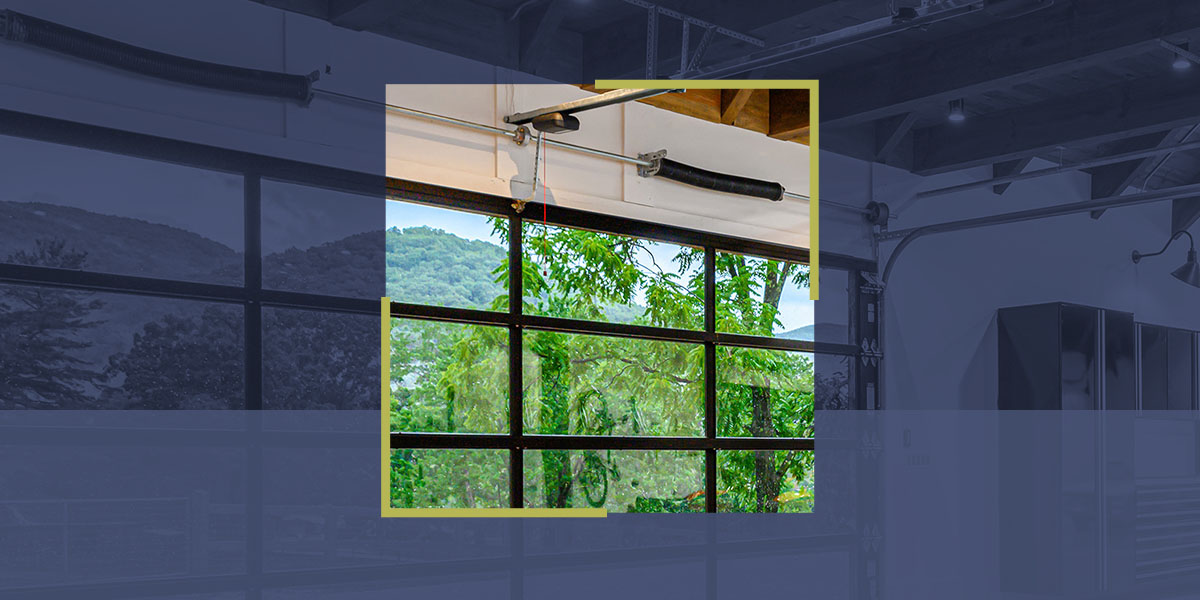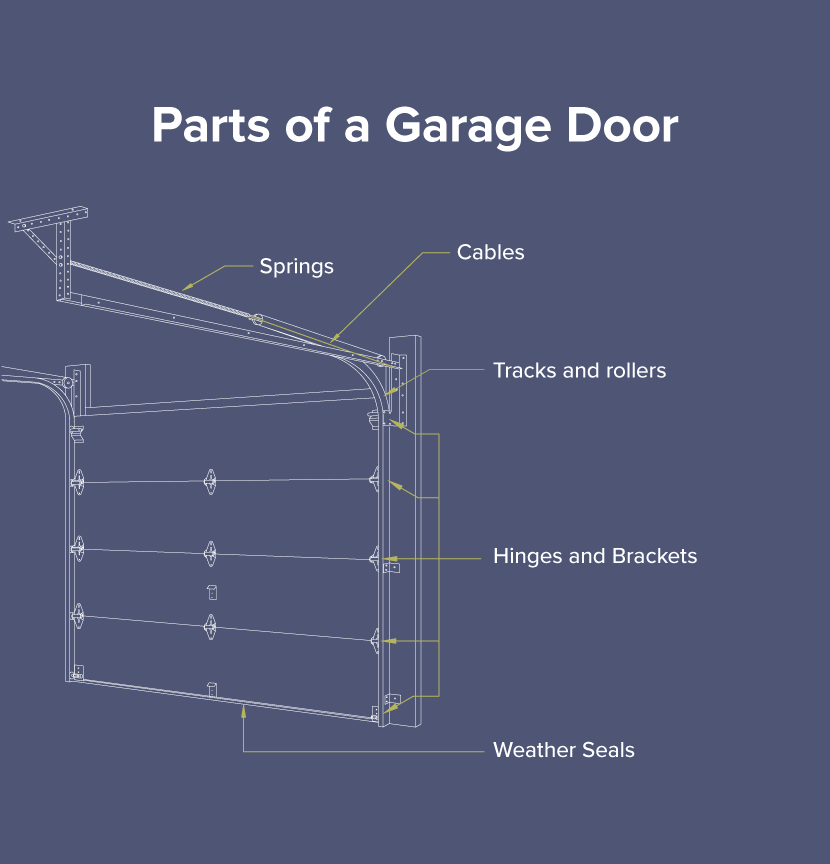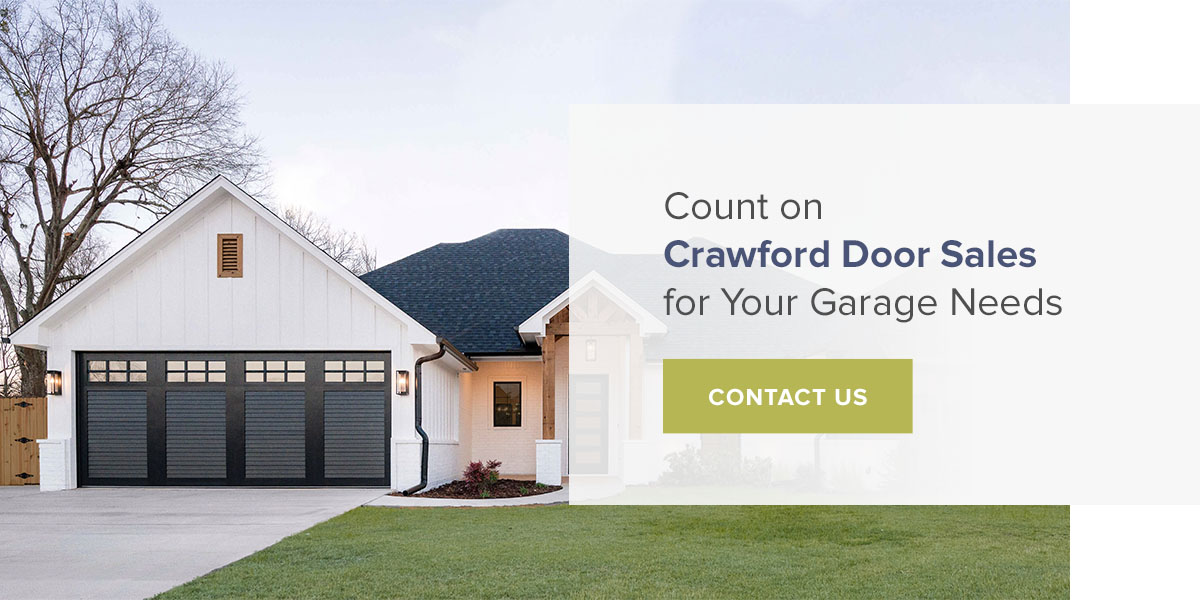
Your garage door is an essential element in your day-to-day life. A garage door plays many roles, whether you rely on it to exit or enter your home, protect your equipment or safeguard your home or business from intruders.
Although the door function may appear seamless, many components work hard to allow entrances and exits. Each element is vital to the door’s movement, and understanding how they work can ensure your door stays in the best shape. Learn what the parts of a garage door are called and how they work to lift and lower your door.
Table of Contents
How Does a Garage Door System Work?
Your garage functions when all the components in the system work together. When it’s time for the door to raise or lower, you can do so with the push of a button. When the motor runs, the other parts of a garage structure respond. The door will slide open by moving over rollers along a track to reach the ceiling. Additional components counter the door’s weight, allowing it to move up and down seamlessly.
What Are the Parts of a Garage Door?
Understanding your garage door parts can be helpful when you need to make repairs, require new door installation or want to consider customization options. The better you know the parts, the more easily you can determine the best solution for your door and space. Here are the essential garage door components to understand:
Garage Door Opener
Your opener is a vital component of your system. Without this piece, your door would not receive instructions to open or close. One of the most important parts of a garage door opener system is the sensor that triggers when it’s time to respond. This sensor often has a distance sensitivity, so you can rest assured that you won’t accidentally open the door from the remote while away.
Tracks and Rollers
The rollers and tracks allow your door to slide up and down. Rollers will often have a metal rod and wheel made of steel or nylon. Rollers glide on the tracks fit along the door sides.
The tracks run vertically on either side of the door and above it along the ceiling. The tracks guide the door where it needs to go while it moves along the rollers to open or close. Most doors have a safety feature to prevent the door from opening if it comes off the track to avoid damage and injuries.
Springs
Although the motor signals when to open or close the door, the springs produce the energy the system needs to lift or lower the door. Depending on the age and model of your door, it has torsion or extension springs. Most modern doors will have torsion springs above the door, but older homes and businesses may have extension springs on the horizontal track.
These springs harness potential energy that controls the door’s movement and prevents it from slamming shut or snapping open. If you experience either of these issues, call a professional for immediate assistance, as garage door springs can injure people or cause damage if they fly free.

Hinges and Brackets
These metal pieces hold other components in place and connect sections of your door together. Hinges are in the middle of the door to attach the panels and bend as the door opens or closes. Brackets typically keep rollers and cables fastened on the door sides.
Panels
Panels act as a protective layer and a stylish choice. Panels come in various styles and face the outdoors. Typically, you can choose between wood, aluminum, steel, vinyl or fiberglass panels to achieve your preferred look. These can boost curb appeal for a home or business and protect the rest of your garage door components from the elements.
Cables
Metal lifting cables on either side of the door connect the door and the opening mechanism. Each garage door cable attaches to the bottom of the door and stretches to the top of the door to reach the drum. As the drum rotates, the cable rolls up, lifting the door.
Drums
The drums connect to the cables, lifting and lowering your door when needed. They also connect to the tube shaft and act as pulley wheels. The drums rotate when the springs release energy. In turn, this will cause the cables to move.
Tube Shaft
The tube shaft runs across the top of the door and holds the springs in place. It remains stationary and ensures the springs can function properly, allowing the cables and drums to react to their energy.
Weather Seals
For additional protection, your door will have a weather seal to protect the door and items inside the garage from natural elements. The weather seal runs along the door bottom, preventing drafts, rain, snow, insects and debris from entering. This helps increase the door’s energy efficiency and can extend the life span of other door components by protecting them from weather conditions and pests that could damage them.
Emergency Cord
The emergency cord is a safety feature that can disengage the door from the opener. This cord hangs on the inside of the door and disconnects the door from the motor when pulled. It typically has a red tag to indicate the safety feature and ensure no one pulls it accidentally.
Although the motor is disengaged, the springs still function, allowing you manually open the door. This feature is excellent when you want to perform maintenance without the risk of accidental opening or closing. For example, a homeowner who needs to open the door halfway could use the emergency cord to prevent someone else from opening the door with a remote while they work.
Safety Sensor
Another safety feature on your door is the safety sensor. Similar to the emergency cord, these photo eye sensors can stop the door from moving. The photo eye has two sensors, which you can locate on either side of the door near the floor. One sensor projects a beam to the other across the door. If an object or person is underneath your door, the beam will break, signaling to the door that it is unsafe to lower.
Count on Crawford Door Sales for Your Garage Needs
Crawford Door Sales is family-owned and operated. We’ve had the pleasure of serving commercial and residential garage door owners for more than 60 years. Our vast experience has empowered us to offer superior service and products to anyone needing to keep their door in tip-top shape or replace an existing system.
Our goal is to provide the best professional installation, deliver high-quality service and offer the best products available to each customer. We can help you learn more about garage doors or repair or replace an existing one. Call us or fill out our contact form, and let us be your one-stop shop for all your garage door needs.


